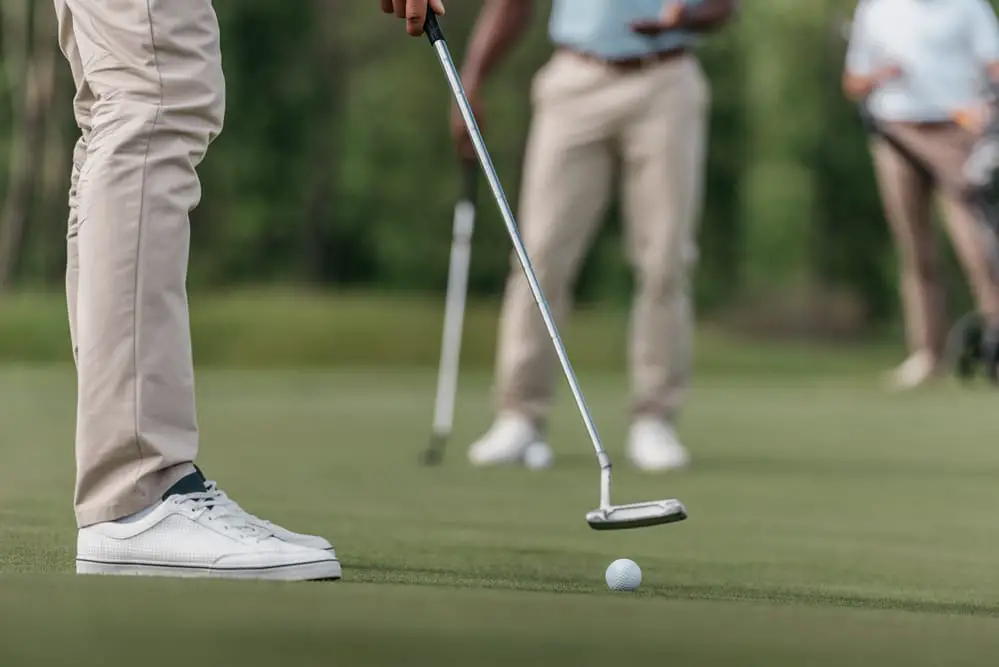Last Updated on October 27, 2023
Chipping a golf ball is one of the most challenging and important skills in any golfer’s arsenal. Whether you’re an experienced pro or just starting out, mastering how to chip a golf ball can take your game from average to extraordinary. In this blog post, we’ll look at some key tips for success when chipping a golf ball. From getting the right grip on your club all the way through aiming for accuracy with every shot, these tried-and-true methods will help you achieve that perfect chip each time. So let’s get started – grab your clubs, and let’s learn how to properly chip a golf ball.
Table of Contents:
- Grip it and Chip It
- Choose Your Club Wisely
- Aim For Accuracy
- Hit It Right
- FAQs in Relation to How to Chip a Golf Ball
- Conclusion
Grip it and Chip It
When gripping your club, it’s important to ensure that your hands are placed correctly on the handle. Your left hand should be slightly lower than your right, and both hands should be evenly spaced out along the length of the handle. Make sure that each finger is securely wrapped around with no gaps between them and that they are firmly touching each other for maximum control over the club head.
Your thumbs should also be pointing down towards the ground, creating an “L” shape with your arms at the address position. This will help keep everything in line as you swing through impact and give you more control over where you want to hit it. It’s also important to maintain light pressure throughout your entire swing so that you don’t lose any power or accuracy during contact with the ball.
Lastly, remember to always stay relaxed while swinging; tension leads to poor shots, so take some deep breaths before addressing every shot if needed.

Choose Your Club Wisely
The most common clubs used for chipping are the pitching wedge, sand wedge and lob wedge. Pitching wedges are typically used for shots that require more distance than a chip shot would usually cover. Sand wedges have higher lofts and can be useful when you need to get out of tight spots or bunkers. Lob wedges have even higher lofts and can help you overcome obstacles such as trees or other hazards on the course.
It’s important to consider your skill level when selecting a club for chipping. Beginners should opt for a pitching wedge with less loft because they can control their swing better with this type of club due to its lower loft angle, which allows them to hit shorter shots with greater accuracy. Experienced golfers may want to use a sand or lob wedge depending on how far away from the hole they are trying to chip from. These clubs provide more spin, which helps control where the ball lands after it has been struck by the club face.
The grip is also a crucial element in determining which club will be most suitable for your particular situation; those with weaker grips may need to opt for higher-lofted clubs so as not to overshoot their target area. Conversely, stronger grips allow golfers who prefer power over finesse the ability to select lower-lofted clubs without compromising too much accuracy while gaining extra distance on their shots.
Aim for Accuracy

The goal of the chip shot is to get the ball close to the hole without overshooting or undershooting it. To achieve this, you must be able to accurately aim your clubface at your target and make clean contact with the ball.
The first step in achieving accuracy when chipping is setting up correctly. Make sure that your feet are shoulder-width apart and that you have good balance throughout your swing. You should also keep your head still during the entire motion of the swing so that you can maintain focus on where you want to hit the ball.
Next, pick out a spot just ahead of where you want to land the ball on its final resting place near or in the hole. This will help give you an idea of how much power needs to be used for each shot as well as how high or low trajectory needs to be used depending on what type of lie (grass height) there is between yourself and your target spot.
Hit It Right

Making contact with the golf ball correctly is one of the most important aspects of a successful shot. It’s all about timing and technique, so it’s essential to get it right.
Set Up Position
The first step in making good contact with the golf ball is setting up your position properly. You want to make sure that you have your feet shoulder-width apart and that you are standing straight up with your weight evenly distributed between both legs. Your arms should be relaxed and slightly bent at the elbows, allowing for an easy swing motion when you hit the ball.
Grip & Stance
Once you’ve set up your position, it’s time to focus on grip and stance. Ensure that your hands are firmly gripping the club in a neutral position – not too tight or too loose – while keeping them close together on either side of the handle. As far as stance goes, keep your feet pointed towards where you want to hit the ball while maintaining a slight bend in both knees throughout your swing motion. This will help ensure maximum power when striking through impact with minimal effort from yourself.
Swing Motion
Now comes perhaps one of the most important steps in making good contact with the golf ball – getting into a proper swing motion. Start by taking practice swings without actually hitting any balls until you feel comfortable enough to start swinging for real shots; this will help give you an idea of how much force is needed for each type of shot (i.e., chip shots vs full swings). When ready, begin by shifting some weight onto the back foot before beginning the downswing; then use hips and shoulders to rotate around the body as the club moves forward towards the target area before finally releasing wrists just prior impact point for optimal spin control upon landing.
FAQs in Relation to How to Chip a Golf Ball
What is the easiest way to chip a golf ball?
Chipping a golf ball requires precision and accuracy. The easiest way to chip is to set up with your feet shoulder-width apart, weight on the front foot, and hands slightly ahead of the ball. Keeping your eyes over the ball, take a short backswing while maintaining your wrist hinge. At impact, make sure you hit down on the ball using a descending blow motion for added control. Finally, accelerate through impact and follow through with your swing until you reach waist height or higher for maximum distance control. With practice and patience, chipping will become second nature.
How do you chip a golf ball step by step?
Chipping a golf ball is an important skill to master for any golfer. To chip a golf ball, start by setting up with your feet slightly wider than shoulder-width apart and the ball positioned just forward of centre in your stance. Next, open the clubface slightly and use a putting stroke motion while keeping your arms close to your body. Finally, make sure you hit down on the ball and accelerate through impact for maximum distance control. With practice, chipping can become second nature.
Why can I not chip a golf ball?
It is important to have the correct technique, as well as the right club selection. To chip successfully, you must ensure that your weight is evenly distributed between both feet and that your hands are in front of the ball at the address. You should also make sure to keep your head down throughout the swing and maintain a consistent tempo. Finally, it is essential to hit down the ball with an accelerating motion through impact for maximum control and distance. With practice and patience, chipping can become second nature.
What is the proper stance for chipping a golf ball?
The proper stance for chipping a golf ball is to stand with your feet slightly wider than shoulder-width apart. Your weight should be evenly distributed on both feet, and your shoulders should be square to the target line. Bend from the hips and knees until you are in a comfortable crouch position. Ensure that your hands are ahead of the clubhead at the address, as this will help ensure that you hit down on the ball when making contact. Finally, keep your head still throughout the swing to maintain control over where you want to send the ball.
Conclusion
With the right grip, club selection, accuracy and technique, you can be sure that you’ll get the most out of every chip shot. So remember: Grip it and Chip It – choose your club wisely – aim for accuracy – hit it right. With practice and dedication, soon enough, you’ll be chipping like a pro.


